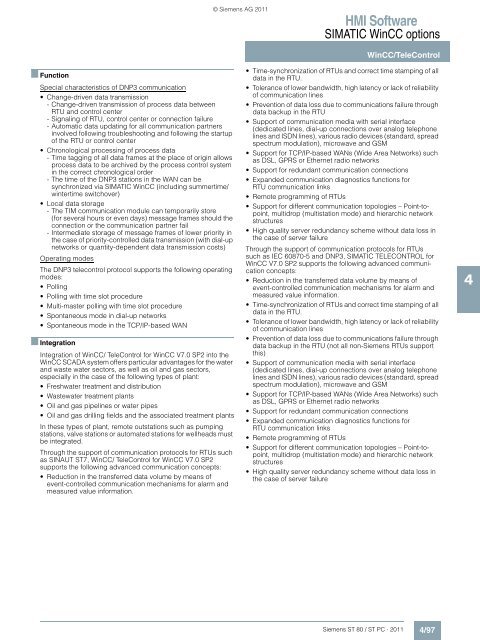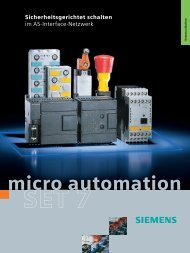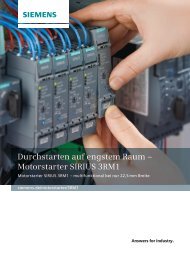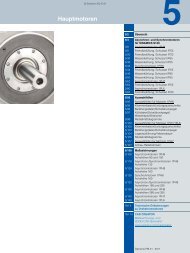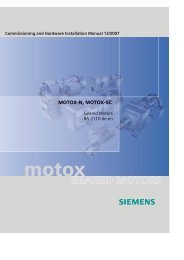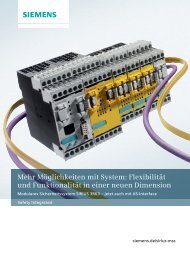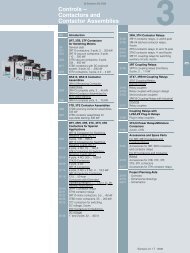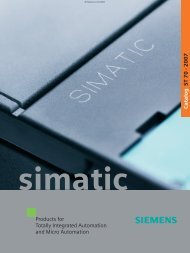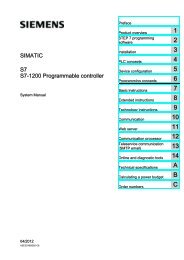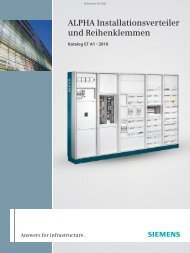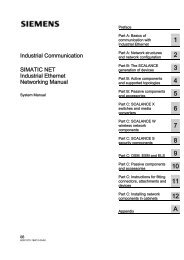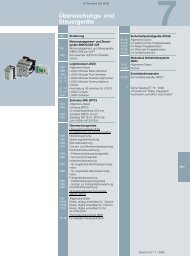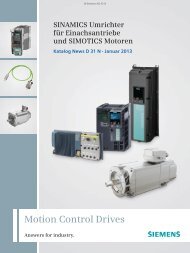- Page 1 and 2:
Human Machine Interface Systems/ PC
- Page 3 and 4:
SIMATIC HMI / PC-based Automation O
- Page 5 and 6:
Siemens offers automation, drive, a
- Page 7 and 8:
SIMATIC HMI Human Machine Interface
- Page 9 and 10:
Communication Industrial Ethernet P
- Page 11 and 12:
Distributed operator control concep
- Page 13 and 14:
Client/Server Mobile Panels Micro P
- Page 15 and 16:
Application examples Unit-type coge
- Page 17 and 18:
Safe transfer at sea For transferri
- Page 19 and 20:
Track & trace line controller for t
- Page 21 and 22:
High-performance industrial PC for
- Page 23 and 24:
2/2 Introduction 2/9 Key Panels 2/9
- Page 25 and 26:
■ Configuration overview Possible
- Page 27 and 28:
■ Technology overview Available -
- Page 29 and 30:
Available - Not available 1) Only M
- Page 31 and 32:
■ Overview SIMATIC HMI Key Panel
- Page 33 and 34:
■ Dimensional drawings All specif
- Page 35 and 36:
■ Function LED color modes (e.g.,
- Page 37 and 38:
■ Overview SIMATIC Push Button Pa
- Page 39 and 40:
© Siemens AG 2011 Operator panels
- Page 41 and 42:
■ Overview 1) ISA-S71.04 severity
- Page 43 and 44:
■ Function Input/output fields fo
- Page 45 and 46:
■ Technical specifications (conti
- Page 47 and 48:
■ Technical specifications (conti
- Page 49 and 50:
■ Technical specifications (conti
- Page 51 and 52:
■ Ordering data Order No. Order N
- Page 53 and 54:
■ Dimensional drawings (continued
- Page 55 and 56:
■ Ordering data Order No. Order N
- Page 57 and 58:
■ Design KTP400 Comfort 4.3" wide
- Page 59 and 60:
■ Technical specifications Operat
- Page 61 and 62:
© Siemens AG 2011 Operator panels
- Page 63 and 64:
■ Technical specifications (conti
- Page 65 and 66:
■ Ordering data Order No. Order N
- Page 67 and 68:
■ Dimensional drawings (continued
- Page 69 and 70:
■ Overview SIMATIC Mobile Panel M
- Page 71 and 72:
■ Design (continued) V
- Page 73 and 74:
■ Overview SIMATIC Moble Panel 17
- Page 75 and 76:
■ Technical specifications SIMATI
- Page 77 and 78:
■ Technical specifications (conti
- Page 79 and 80:
■ Technical specifications (conti
- Page 81 and 82:
Operator panels Mobile Panels — 1
- Page 83 and 84:
© Siemens AG 2011 ■ Overview ■
- Page 85 and 86:
■ Technical specifications SIMATI
- Page 87 and 88:
■ Technical specifications (conti
- Page 89 and 90:
with SIMATIC WinCC flexible Documen
- Page 91 and 92:
■ Overview ■ Function Input/out
- Page 93 and 94:
■ Integration The SIMATIC Mobile
- Page 95 and 96:
■ Technical specifications (conti
- Page 97 and 98:
■ Technical specifications (conti
- Page 99 and 100:
■ Technical specifications (conti
- Page 101 and 102:
■ Technical specifications (conti
- Page 103 and 104:
■ Technical specifications (conti
- Page 105 and 106:
H: Subject to export regulations: A
- Page 107 and 108:
■ Overview The user-friendly text
- Page 109 and 110:
■ Ordering data Order No. ■ Dim
- Page 111 and 112:
■ Function Display of message tex
- Page 113 and 114:
■ Overview Operator Panel for con
- Page 115 and 116:
Mounting cutout/device depth (W x H
- Page 117 and 118:
■ Overview Touch Panel for operat
- Page 119 and 120:
■ Technical specifications (conti
- Page 121 and 122:
■ Overview The user-friendly text
- Page 123 and 124:
■ Overview Operator Panel for ope
- Page 125 and 126:
■ Technical specifications (conti
- Page 127 and 128:
■ Overview Compact Operator Panel
- Page 129 and 130:
■ Technical specifications (conti
- Page 131 and 132:
■ Overview Compact Operator Panel
- Page 133 and 134:
■ Technical specifications 6AV6 6
- Page 135 and 136:
■ Dimensional drawings All specif
- Page 137 and 138:
■ Function Templates concept for
- Page 139 and 140:
© Siemens AG 2011 Operator panels
- Page 141 and 142:
■ Overview Touch Panel with exten
- Page 143 and 144:
■ Technical specifications Operat
- Page 145 and 146:
© Siemens AG 2011 Operator panels
- Page 147 and 148:
■ Dimensional drawings All specif
- Page 149 and 150:
■ Design 256 colors with color di
- Page 151 and 152:
■ Technical specifications (conti
- Page 153 and 154:
■ Overview Touch Panel with exten
- Page 155 and 156:
■ Technical specifications 6AV6 6
- Page 157 and 158:
■ Dimensional drawings All dimens
- Page 159 and 160:
■ Design 256-color TFT display CC
- Page 161 and 162:
■ Technical specifications (conti
- Page 163 and 164:
■ Overview Operator panel for ope
- Page 165 and 166:
■ Overview Operator panels SIPLUS
- Page 167 and 168:
■ Overview Operator panels SIPLUS
- Page 169 and 170:
■ Design Compact design with low
- Page 171 and 172:
■ Technical specifications (conti
- Page 173 and 174:
■ Overview Like operator panels,
- Page 175 and 176:
© Siemens AG 2011 Operator panels
- Page 177 and 178:
■ Technical specifications (conti
- Page 179 and 180:
Operator panels Multi Panels — 27
- Page 181 and 182:
■ Dimensional drawings All specif
- Page 183 and 184:
■ Application The Multi Panels SI
- Page 185 and 186:
■ Technical specifications Operat
- Page 187 and 188:
© Siemens AG 2011 Operator panels
- Page 189 and 190:
■ Ordering data Order No. Order N
- Page 191 and 192:
■ Overview WinAC MP, the software
- Page 193 and 194:
■ Technical specifications © Sie
- Page 195 and 196:
Operator panels Multi Panel options
- Page 197 and 198:
■ Overview Multi Panels (MP) are
- Page 199 and 200:
■ Overview Multi Panels (MP) are
- Page 201 and 202:
■ Overview The following types of
- Page 203 and 204:
■ Overview (continued) Controller
- Page 205 and 206:
■ Overview (continued) Controller
- Page 207 and 208:
■ Overview Allen Bradley Three co
- Page 209 and 210:
■ Overview (continued) Controller
- Page 211 and 212:
■ Overview (continued) Controller
- Page 213 and 214:
■ Overview The SIMATIC Touch Pane
- Page 215 and 216:
■ Overview (continued) Controller
- Page 217 and 218:
■ Overview (continued) Controller
- Page 219 and 220:
■ Overview (continued) Controller
- Page 221 and 222:
■ Overview Example - connecting c
- Page 223 and 224:
■ Overview (continued) DP PtP DP
- Page 225 and 226:
1) Included in PG scope of delivery
- Page 227 and 228:
■ Overview © Siemens AG 2011 Ope
- Page 229 and 230:
Operator panels HMI Accessories Acc
- Page 231 and 232:
■ Ordering data Order No. ■ Dim
- Page 233 and 234:
■ Overview ■ Technical specific
- Page 235 and 236:
■ Overview USB 2.0 flash drive ©
- Page 237 and 238:
■ Overview The service packs list
- Page 239 and 240:
© Siemens AG 2011 Operator panels
- Page 241 and 242:
■ Ordering data Order No. Order N
- Page 243 and 244:
© Siemens AG 2011 ■ Overview Pri
- Page 245 and 246:
© Siemens AG 2011 HMI devices for
- Page 247 and 248:
■ Overview The new SIMATIC fully
- Page 249 and 250:
■ Overview SIMATIC MP 377 PRO 15"
- Page 251 and 252:
■ Dimensional drawings All specif
- Page 253 and 254:
■ Ordering data Order No. SIMATIC
- Page 255 and 256:
■ Ordering data Order No. SIMATIC
- Page 257 and 258:
© Siemens AG 2011 HMI devices for
- Page 259 and 260:
HMI devices for special requirement
- Page 261 and 262:
■ Overview Adapter sets The adapt
- Page 263 and 264:
■ Overview ■ Integration © Sie
- Page 265 and 266:
■ Overview For special requiremen
- Page 267 and 268:
■ Function Permanent window and t
- Page 269 and 270:
■ Technical specifications (conti
- Page 271 and 272:
■ Overview Like operator panels,
- Page 273 and 274:
■ Function (continued) Password s
- Page 275 and 276:
■ Technical specifications (conti
- Page 277 and 278:
■ Overview Like operator panels,
- Page 279 and 280:
■ Integration The MP 377 can be c
- Page 281 and 282:
■ Ordering data SIMATIC MP 377 IN
- Page 283 and 284:
■ Design The Panel PC 677B INOX c
- Page 285 and 286:
■ Function Integrated, parameteri
- Page 287 and 288:
HMI devices for special requirement
- Page 289 and 290:
■ Overview PC platform with high
- Page 291 and 292:
© Siemens AG 2011 HMI devices for
- Page 293 and 294:
HMI devices for special requirement
- Page 295 and 296:
■ Overview The SIMATIC HMI Ex dev
- Page 297 and 298:
■ Overview SIMATIC HMI Panel PC E
- Page 299 and 300:
■ Dimensional drawings All specif
- Page 301 and 302:
A: Subject to export regulations: A
- Page 303 and 304:
HMI Software 4/2 HMI Software 4/2 I
- Page 305 and 306:
■ Overview (continued) SIMATIC Wi
- Page 307 and 308:
■ Overview Integrated family of e
- Page 309 and 310:
© Siemens AG 2011 HMI Software HMI
- Page 311 and 312:
■ Overview SIMATIC WinCC Runtime
- Page 313 and 314:
■ Function (continued) Documentat
- Page 315 and 316:
HMI Software SIMATIC WinCC (TIA Por
- Page 317 and 318:
■ Function (continued) Recipes 1)
- Page 319 and 320:
■ Technical specifications The fo
- Page 321 and 322:
■ Overview MPI, PROFIBUS (S7 comm
- Page 323 and 324:
■ Overview (continued) Communicat
- Page 325 and 326:
HMI Software SIMATIC WinCC (TIA Por
- Page 327 and 328:
■ Overview Options for SIMATIC Pa
- Page 329 and 330:
■ Technical specifications WinCC
- Page 331 and 332:
■ Technical specifications WinCC
- Page 333 and 334:
■ Overview Option for connecting
- Page 335 and 336:
■ Application Operator control an
- Page 337 and 338:
Mobile Panel 277, TP/OP 277, MP 277
- Page 339 and 340:
■ Benefits Integrated scalability
- Page 341 and 342:
■ Benefits Operator control and m
- Page 343 and 344:
■ Overview Uniform family of engi
- Page 345 and 346:
■ Function (continued) Project do
- Page 347 and 348: HMI Software SIMATIC WinCC flexible
- Page 349 and 350: ■ Function Visualization via Wind
- Page 351 and 352: ■ Integration (continued) Applica
- Page 353 and 354: HMI Software SIMATIC WinCC flexible
- Page 355 and 356: ■ Overview Option for SIMATIC Win
- Page 357 and 358: ■ Overview Option for SIMATIC Win
- Page 359 and 360: ■ Overview Option for SIMATIC Win
- Page 361 and 362: © Siemens AG 2011 HMI Software SIM
- Page 363 and 364: ■ Application (continued) Industr
- Page 365 and 366: ■ Technical specifications Type W
- Page 367 and 368: ■ Function (continued) Remote op
- Page 369 and 370: ■ Overview Option for SIMATIC Win
- Page 371 and 372: ■ Overview © Siemens AG 2011 G_
- Page 373 and 374: ■ Benefits (continued) Innovation
- Page 375 and 376: WinCC supports the standards: OPC D
- Page 377 and 378: ■ Integration (continued) Communi
- Page 379 and 380: ■ Communications examples (contin
- Page 381 and 382: ■ Technical specifications 1) An
- Page 383 and 384: HMI Software SCADA system SIMATIC W
- Page 385 and 386: HMI Software SCADA system SIMATIC W
- Page 387 and 388: HMI Software SCADA system SIMATIC W
- Page 389 and 390: ■ More information WinCC language
- Page 391 and 392: ■ Overview WinCC Server TERMINAL
- Page 393 and 394: ■ Overview Option for
- Page 395 and 396: ■ Design Licenses for the Web Nav
- Page 397: ■ More information System require
- Page 401 and 402: ■ Ordering data Order No. Order N
- Page 403 and 404: ■ Overview
- Page 405 and 406: ■ Design The SIMATIC Maintenance
- Page 407 and 408: ■ Overview Precise and rapid proc
- Page 409 and 410: ■ Function Acquiring and conditio
- Page 411 and 412: ■ Overview Energy Management Syst
- Page 413 and 414: Counter 2 Energy planning Generatio
- Page 415 and 416: ■ Overview The WinCC/DataMonitor
- Page 417 and 418: ■ Overview The entry point to SIM
- Page 419 and 420: ■ Overview Cross-vendor communica
- Page 421 and 422: ■ Ordering data Order No. Order N
- Page 423 and 424: ■ Benefits Connecting the automat
- Page 425 and 426: ■ Overview Option for SIMATIC Win
- Page 427 and 428: ■ Overview Option for SIMATIC Win
- Page 429 and 430: ■ Function The functions of SIMAT
- Page 431 and 432: ■ Function © Siemens AG 2011 HMI
- Page 433 and 434: ■ Overview WinCC/IndustrialX make
- Page 435 and 436: ■ Overview WinCC Option WinCC Opt
- Page 437 and 438: ■ Overview SIMATIC WinCC Open Arc
- Page 439 and 440: ■ Function (continued) A WinCC OA
- Page 441 and 442: ■ Function (continued) Add-ons Ta
- Page 443 and 444: ■ Integration Integration in auto
- Page 445 and 446: HMI Software SCADA System WinCC Ope
- Page 447 and 448: HMI Software SCADA System WinCC Ope
- Page 449 and 450:
HMI Software SCADA System WinCC Ope
- Page 451 and 452:
HMI Software SCADA System WinCC Ope
- Page 453 and 454:
■ Function Context-sensitive diag
- Page 455 and 456:
© Siemens AG 2011 HMI Software SIM
- Page 457 and 458:
5/2 Industrial PC 5/4 Rack PC 5/10
- Page 459 and 460:
PC-based Automation SIMATIC Industr
- Page 461 and 462:
■ Overview (continued) SIMATIC IP
- Page 463 and 464:
Available - Not available 1) Suitab
- Page 465 and 466:
■ Benefits © Siemens AG 2011 PC-
- Page 467 and 468:
■ Benefits (continued) High indus
- Page 469 and 470:
■ Function Multi Core processor t
- Page 471 and 472:
■ Technical specifications (conti
- Page 473 and 474:
PC-based Automation Rack PC ■ Ord
- Page 475 and 476:
■ Overview The SIMATIC IPC547C is
- Page 477 and 478:
■ Design (continued) Front view o
- Page 479 and 480:
■ Technical specifications (conti
- Page 481 and 482:
PC-based Automation Rack PC ■ Ord
- Page 483 and 484:
■ Overview The SIMATIC IPC647C is
- Page 485 and 486:
■ Design (continued) Fieldbus onb
- Page 487 and 488:
■ Technical specifications (conti
- Page 489 and 490:
PC-based Automation Rack PC ■ Ord
- Page 491 and 492:
PC-based Automation Rack PC Siemens
- Page 493 and 494:
■ Overview The SIMATIC IPC847C is
- Page 495 and 496:
■ Design (continued) Design versi
- Page 497 and 498:
■ Technical specifications SIMATI
- Page 499 and 500:
■ Technical specifications (conti
- Page 501 and 502:
PC-based Automation Rack PC ■ Ord
- Page 503 and 504:
■ Dimensional drawings All specif
- Page 505 and 506:
■ Benefits (continued) Reduced co
- Page 507 and 508:
■ Function Dual Core processor te
- Page 509 and 510:
■ Technical specifications (conti
- Page 511 and 512:
PC-based Automation Rack PC ■ Ord
- Page 513 and 514:
■ Dimensional drawings All specif
- Page 515 and 516:
■ Overview (continued) SIMATIC IP
- Page 517 and 518:
■ Benefits © Siemens AG 2011 PC-
- Page 519 and 520:
■ Application The SIMATIC IPC227D
- Page 521 and 522:
■ Function Diagnosis Integrated,
- Page 523 and 524:
© Siemens AG 2011 Note: PC-based A
- Page 525 and 526:
■ Dimensional drawings (continued
- Page 527 and 528:
■ Application The SIMATIC IPC427C
- Page 529 and 530:
■ Technical specifications SIMATI
- Page 531 and 532:
PC-based Automation Box PC ■ Orde
- Page 533 and 534:
■ Accessories SIMATIC IPC427C wit
- Page 535 and 536:
■ Overview The SIMATIC IPC627C Bo
- Page 537 and 538:
■ Design (continued) Design versi
- Page 539 and 540:
■ Technical specifications (conti
- Page 541 and 542:
PC-based Automation Box PC Siemens
- Page 543 and 544:
■ Dimensional drawings All specif
- Page 545 and 546:
■ Benefits (continued) High syste
- Page 547 and 548:
■ Technical specifications SIMATI
- Page 549 and 550:
■ Technical specifications (conti
- Page 551 and 552:
PC-based Automation Box PC Siemens
- Page 553 and 554:
■ Overview The SIMATIC Box PC 827
- Page 555 and 556:
© Siemens AG 2011 PC-based Automat
- Page 557 and 558:
■ Technical specifications (conti
- Page 559 and 560:
Note: PC-based Automation Box PC SI
- Page 561 and 562:
■ Overview SIMATIC Panel PCs are
- Page 563 and 564:
■ Overview (continued) Ambient co
- Page 565 and 566:
■ Overview SIMATIC HMI IPC277D fo
- Page 567 and 568:
■ Design (continued) SIMATIC HMI
- Page 569 and 570:
■ Technical specifications (conti
- Page 571 and 572:
■ Dimensional drawings All specif
- Page 573 and 574:
■ Design The HMI IPC477C is a com
- Page 575 and 576:
■ Design (continued) Operation of
- Page 577 and 578:
■ Technical specifications (conti
- Page 579 and 580:
PC-based Automation SIMATIC Panel P
- Page 581 and 582:
■ Dimensional drawings (continued
- Page 583 and 584:
■ Design The SIMATIC HMI IPC is e
- Page 585 and 586:
■ Technical specifications (conti
- Page 587 and 588:
PC-based Automation SIMATIC Panel P
- Page 589 and 590:
■ Dimensional drawings (continued
- Page 591 and 592:
■ Design The SIMATIC HMI IPC677C
- Page 593 and 594:
■ Technical specifications 6AV7 8
- Page 595 and 596:
A: Subject to export regulations: A
- Page 597 and 598:
■ Overview Panel PC 677B PC platf
- Page 599 and 600:
■ Design (continued) Expansion co
- Page 601 and 602:
■ Technical specifications (conti
- Page 603 and 604:
© Siemens AG 2011 PC-based Automat
- Page 605 and 606:
■ Overview Siemens has developed
- Page 607 and 608:
■ Overview SIMATIC WinAC RTX: opt
- Page 609 and 610:
■ Technical specifications 6ES7 6
- Page 611 and 612:
■ Technical specifications (conti
- Page 613 and 614:
■ Technical specifications (conti
- Page 615 and 616:
PC-based Automation PC-based Contro
- Page 617 and 618:
■ Overview SIMATIC WinAC RTX F: O
- Page 619 and 620:
■ Technical specifications 6ES7 6
- Page 621 and 622:
■ Technical specifications (conti
- Page 623 and 624:
■ Technical specifications (conti
- Page 625 and 626:
A: Subject to export regulations: A
- Page 627 and 628:
■ Overview SIMATIC WinAC software
- Page 629 and 630:
© Siemens AG 2011 PC-based Automat
- Page 631 and 632:
■ Overview (continued) Decision a
- Page 633 and 634:
■ Design The S7-mEC automation sy
- Page 635 and 636:
■ Technical specifications (conti
- Page 637 and 638:
■ Technical specifications (conti
- Page 639 and 640:
■ Technical specifications (conti
- Page 641 and 642:
■ Technical specifications (conti
- Page 643 and 644:
■ Overview Get off to a fast star
- Page 645 and 646:
■ Technical specifications © Sie
- Page 647 and 648:
■ Overview The Embedded Bundles f
- Page 649 and 650:
■ Function Controlling: For the o
- Page 651 and 652:
■ More information Delivery Produ
- Page 653 and 654:
■ Function Controlling: For the o
- Page 655 and 656:
("Built to order" with delivery tim
- Page 657 and 658:
■ Overview SIMATIC HMI IPC277D fo
- Page 659 and 660:
Interfaces: 2 x Gbit LAN (RJ45), 1
- Page 661 and 662:
■ Overview Embedded PC platform w
- Page 663 and 664:
■ Design (continued) SIMATIC IPC
- Page 665 and 666:
■ Technical specifications (conti
- Page 667 and 668:
PC-based Automation Embedded Panel
- Page 669 and 670:
PC-based Automation Software packag
- Page 671 and 672:
■ Design Rugged aluminum front TF
- Page 673 and 674:
© Siemens AG 2011 PC-based Automat
- Page 675 and 676:
■ Dimensional drawings All specif
- Page 677 and 678:
■ Overview The SCD 19101 D/DT mon
- Page 679 and 680:
■ Overview The SIMATIC HMI SCD 19
- Page 681 and 682:
■ Dimensional drawings All specif
- Page 683 and 684:
■ Design SIMATIC Thin Client is i
- Page 685 and 686:
PC-based Automation Industrial Moni
- Page 687 and 688:
■ Overview RMOS3 is the real-time
- Page 689 and 690:
■ Design RMOS3 impresses customer
- Page 691 and 692:
© Siemens AG 2011 PC-based Automat
- Page 693 and 694:
PC-based Automation RMOS3 real-time
- Page 695 and 696:
■ Design The RMOS3-GNU developmen
- Page 697 and 698:
© Siemens AG 2011 PC-based Automat
- Page 699 and 700:
■ Overview The RMOS3-TCP/IP V3.0
- Page 701 and 702:
■ Function (continued) Characteri
- Page 703 and 704:
■ Overview RMOS3-GRAPHX V1.0 prov
- Page 705 and 706:
© Siemens AG 2011 PC-based Automat
- Page 707 and 708:
■ Design The configurable nucleus
- Page 709 and 710:
© Siemens AG 2011 PC-based Automat
- Page 711 and 712:
■ Overview SIMATIC PCs offer user
- Page 713 and 714:
■ Overview Rugged systems are req
- Page 715 and 716:
■ Overview The SINUMERIK 3.5" flo
- Page 717 and 718:
■ Application The SIMATIC HMI IPC
- Page 719 and 720:
■ Technical specifications (conti
- Page 721 and 722:
■ Technical specifications (conti
- Page 723 and 724:
© Siemens AG 2011 PC-based Automat
- Page 725 and 726:
© Siemens AG 2011 PC-based Automat
- Page 727 and 728:
■ Overview SIMATIC IPC Image & Pa
- Page 729 and 730:
■ Overview SIMATIC IPC DiagMonito
- Page 731 and 732:
■ Overview SIMATIC IPC Remote Man
- Page 733 and 734:
■ Overview The SIMATIC IPC BIOS M
- Page 735 and 736:
© Siemens AG 2011 PC-based Automat
- Page 737 and 738:
■ Overview By combining a DC UPS
- Page 739 and 740:
■ Overview SITOP Power DC UPS mod
- Page 741 and 742:
■ Overview SITOP Power Battery mo
- Page 743 and 744:
■ Overview Uninterruptible power
- Page 745 and 746:
■ Overview The SIMATIC PC accesso
- Page 747 and 748:
■ Overview The T 2240/24 is a rug
- Page 749 and 750:
■ Overview The 2150 is a multifun
- Page 751 and 752:
■ Overview ■ Technical specific
- Page 753 and 754:
■ Overview The built-in version o
- Page 755 and 756:
■ Overview Even with the mouse we
- Page 757 and 758:
■ Overview © Siemens AG 2011 PC-
- Page 759 and 760:
■ Overview © Siemens AG
- Page 761 and 762:
■ Overview PCI module for
- Page 763 and 764:
PC-based Automation Communication
- Page 765 and 766:
■ Overview PCI Express Ca
- Page 767 and 768:
■ Overview System configuration S
- Page 769 and 770:
■ Overview S7-1200 CSM 1277 S
- Page 771 and 772:
■ Overview PC with SOFTNET PN IO
- Page 773 and 774:
■ Overview PC/Windows PC DP OPC s
- Page 775 and 776:
■ Overview OPC (Openness, Product
- Page 777 and 778:
PC-based Automation Communication
- Page 779 and 780:
■ Overview SINEMA Server is a web
- Page 781 and 782:
■ Overview Note: FMS-5613 support
- Page 783 and 784:
■ Overview © Siemens AG 2011 PC
- Page 785 and 786:
■ Overview © Siemens AG 2011 PC
- Page 787 and 788:
■ Overview © Siemens AG 2011 PC
- Page 789 and 790:
■ Overview © Siemens AG 2011 PC
- Page 791 and 792:
■ Overview PC Card Type II
- Page 793 and 794:
■ Overview PCI Express card
- Page 795 and 796:
■ Overview PROFIBUS S5-115U to S
- Page 797 and 798:
■ Overview PC/Windows PC DP OPC s
- Page 799 and 800:
■ Overview OPC (Openness, Product
- Page 801 and 802:
© Siemens AG 2011 Customized Autom
- Page 803 and 804:
■ Benefits Time savings you can u
- Page 805 and 806:
■ Overview For machines and syste
- Page 807 and 808:
For all other products not listed h
- Page 809 and 810:
■ Overview MP 377 15" Touch OEM a
- Page 811 and 812:
■ Overview Function cards are PC
- Page 813 and 814:
■ Overview OEM MP 277 8.4" Touch
- Page 815 and 816:
■ Technical specifications 7.5" T
- Page 817 and 818:
■ Overview Professional display s
- Page 819 and 820:
■ Technical specifications (conti
- Page 821 and 822:
■ Overview Front view with speake
- Page 823 and 824:
■ Overview Turnkey products are r
- Page 825 and 826:
■ Design The HMI operator station
- Page 827 and 828:
Backplane cover MP 377 19"/ Flat Pa
- Page 829 and 830:
■ Application Remote Operate Soft
- Page 831 and 832:
■ Technical specifications © Sie
- Page 833 and 834:
■ Overview SIMATIC HMI products a
- Page 835 and 836:
■ Overview Wind farms Wind farms
- Page 837 and 838:
■ Design The modular design with
- Page 839 and 840:
■ Overview Push Button Panel PP17
- Page 841 and 842:
For further technical specification
- Page 843 and 844:
■ Overview Front panel 15" with f
- Page 845 and 846:
■ Overview Front view For high-co
- Page 847 and 848:
Customized Automation Automotive in
- Page 849 and 850:
■ Ordering data Order No. Customi
- Page 851 and 852:
■ Overview The Front Panel Touch
- Page 853 and 854:
■ Overview Ideal for machine-leve
- Page 855 and 856:
■ Benefits (continued) Certificat
- Page 857 and 858:
■ Technical specifications (conti
- Page 859 and 860:
■ Overview MP 377 12" Touch, rear
- Page 861 and 862:
■ Overview Flat Panel 15" Touch I
- Page 863 and 864:
■ Overview SIMATIC HMI Panels or
- Page 865 and 866:
■ Overview Ideal for use in the o
- Page 867 and 868:
■ Overview TEK - front view TEK -
- Page 869 and 870:
Appendix © Siemens AG 2011 7/2 Tra
- Page 871 and 872:
■ Training offer for SIMATIC HMI
- Page 873 and 874:
■ Overview © Siemens AG 2011 App
- Page 875 and 876:
■ Overview Siemens Solution Partn
- Page 877 and 878:
For machine constructors, solution
- Page 879 and 880:
■ Knowledge Base on DVD ■ Autom
- Page 881 and 882:
■ Overview ■ Our core competenc
- Page 883 and 884:
Numerics 19" slide-in keyboard PS/2
- Page 885 and 886:
SIMATIC TP 177micro ...............
- Page 887 and 888:
6ES7 6ES7 272- ....................
- Page 889 and 890:
■ To Your address Siemens AG, I I
- Page 891 and 892:
Catalogs Industry Automation, Drive


